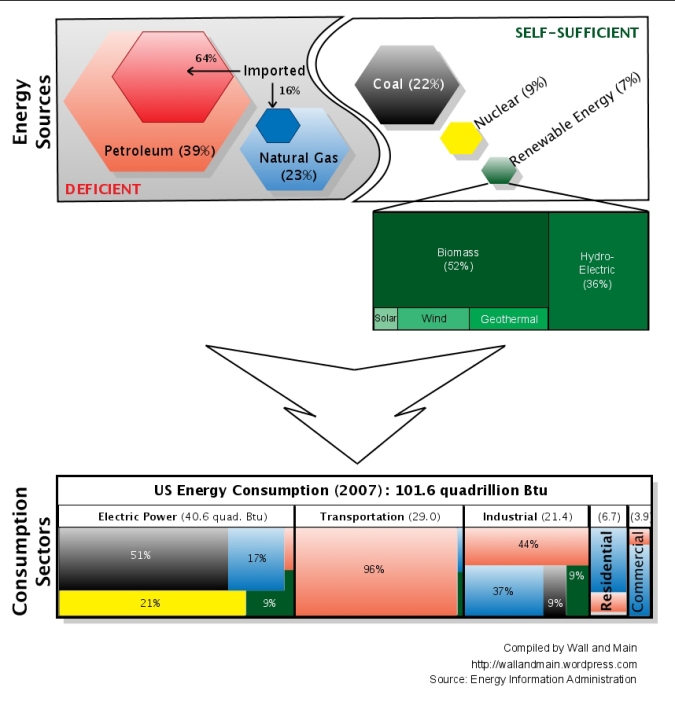 Does the implementation of energy independence and environmental stewardship need to be linked? Can each aspect be tackled separately or in some order of priority?
Does the implementation of energy independence and environmental stewardship need to be linked? Can each aspect be tackled separately or in some order of priority?
Energy independence, considered on its own, would mean that the sources of energy that feed our consumption come from within the United States. Environmental stewardship would involve lower emission of pollutants and greenhouse gases during the production and consumption of each additional Btu of energy.
We currently seem to be tackling two massive issues at the same time with aspects of each pulling in opposite directions and hindering the advancement of either. It seems to me that we would be able to step closer to accomplishing both if we tackle energy independence first. When we control the input-output elements of our nation’s energy, we can better direct our efforts towards environmental stewardship.
The schematic below provides a summary of energy sources, and energy consumption, in the United States in 2007 as compiled from Energy Information Administration data. In order to compare the various sources, I’ve converted the normal units of each into Btu. The colors representing the various sources are consistent within the consumption sectors. This will, hopefully, facilitate quick comprehension of the dynamics between the energy sources and consumption sectors.
The United States consumed 101.6 quadrillion Btu of energy in 2007. 85% of the energy we consumed (in Btu) was provided by petroleum (39%), natural gas (23%), and coal (22%). 64% of our petroleum consumption and 16% of natural gas consumption came from imports. The United States is a net exporter of coal.
 In order to wean ourselves off imported petroleum and natural gas – energy independence – while reducing pollutants and greenhouse gases at the same time – environmental stewardship, it would require the replacement of petroleum and natural gas with renewable energy. Herein lies the challenge of tackling these two major issues at the same time.
In order to wean ourselves off imported petroleum and natural gas – energy independence – while reducing pollutants and greenhouse gases at the same time – environmental stewardship, it would require the replacement of petroleum and natural gas with renewable energy. Herein lies the challenge of tackling these two major issues at the same time.
Since 96% of our transportation needs are met by petroleum-derived products, the replacement fuel from renewable energy sources would have to serve as transportation fuel. This practically eliminates solar, wind, geothermal, and hydro-electric or 48% of 2007 renewable energy production. Only 17.4% of the 3.6 quadrillion Btu of biomass directly contributed to transportation through fuel ethanol and biodiesel. There would, therefore, have to be a 41 fold increase in the production of fuel ethanol and biodiesel to replace current petroleum imports, not to mention the complications associated with setting up infrastructure for the replacement fuel.
I don’t pretend to be an expert in energy infrastructure nor claim to have the perfect solution. However, one viable alternative I see would be to focus the efforts of renewable energy on the nation’s electric grid. As can be seen in the schematic, the electric power sector is one area where all sources have some contribution, especially natural gas and renewable energy. More importantly, almost all sources of renewable energy can be used for the generation of electricity.
Natural gas, according to various sources, is an abundant resource within our country and cleaner burning than petroleum or coal. Measuring natural gas in the ground is no easy job, and it involves a great deal of inference and estimation. With new technologies, these estimates are becoming more and more reliable; however, they are still subject to revision. Three different organizations – Energy Information Administration, National Petroleum Council, and Potential Gas Committee – estimate that the technically recoverable natural gas resources are about 1.5 quadrillion cubic feet. In comparison we produced 19.3 billion cubic feet of natural gas in 2007. In other words, our technically recoverable resources of natural gas are 77,000 times greater than the total production in 2007. Technically recoverable resources include both discovered and undiscovered resources that we currently have the technical capability to extract. Keep in mind that just because a resource is technically recoverable doesn’t mean that it is economically recoverable, where the parties involved have a financial incentive to extract it. Update: On June 18, 2009, the Potential Gas Committee updated its resource numbers for natural gas to 1.84 quadrillion cubic feet.
If clean coal technology is more of a story than a reality, we could focus our efforts on unconventional natural gas – the most abundant form in the United States – and renewable energy (solar, wind, geothermal, hydro-electric, and biomass) such that they become the major contributors to each additional Btu added to the electric power sector.
Transportation, on the other hand, would seem to require one source of power the way gasoline has served consumers and diesel has served commercial vehicles in the past. The infrastructure that is needed to support fuel consumption – filling stations, fuel transport – is the main reason for such a requirement. The ability to go to any gas station and fill one’s vehicles with the same kind of fuel made the adoption of cars and light trucks easier for consumers. I believe the same will be required for the next source of power for consumer vehicles. Electricity is one such option.
Consumer-based transportation (light trucks and smaller vehicles) can gradually be shifted to run on electricity through improved battery technology and recharge stations. 8.8 million gallons of gasoline and 3.4 million gallons of diesel were consumed for transportation purposes last year. Since most of the gasoline is used in cars and light trucks, replacing it with electric power should be sufficient to eliminate the importation of petroleum as the US production of petroleum should be adequate to meet the needs of heavy duty trucks and industrial applications.
Shai Agassi is one of the leaders in the area of electric vehicle services, such as recharging stations, and is currently implementing his vision in Israel.
Experts estimate that the capacity of the electric grid will have to double in order to facilitate a major shift towards electric vehicles, which is why I believe it important to focus all current natural gas and renewable energy efforts to increasing electric capacity.
An added benefit is the the ability to change the mix of sources for electric power generation down the road as we continue to make strides in renewable energy in terms of efficiency and scale. For example, we may be able to wean ourselves off coal and nuclear followed eventually by natural gas. No matter what the input mix and how long it takes us to get there, consumers can rest assured that the output will remain the same – electricity, which will continue to power their homes and vehicles into the future.
Filed under: Energy, Government, Politics, energy independence, environment, imports, natural gas, petroleum, renewable, transportation